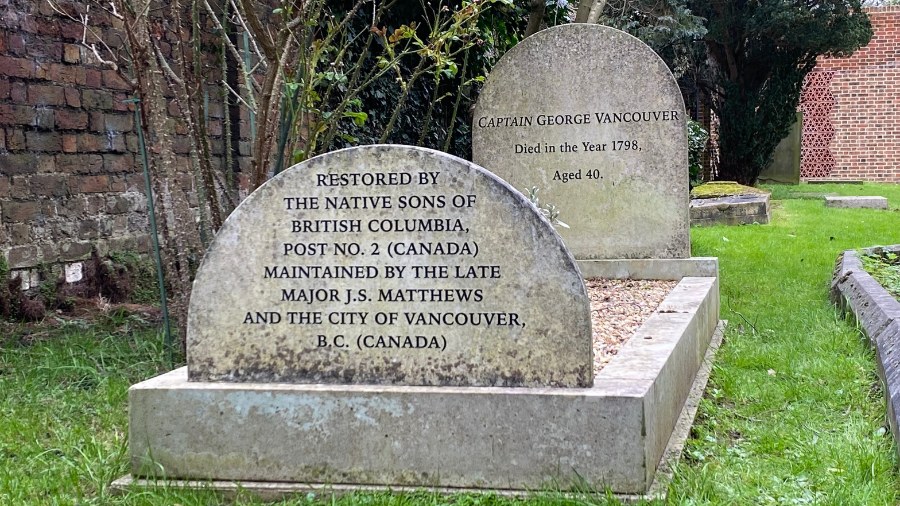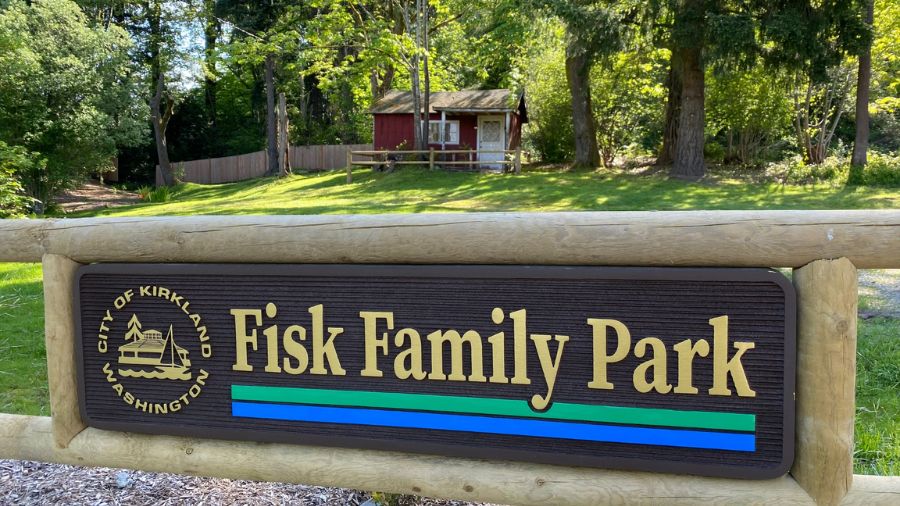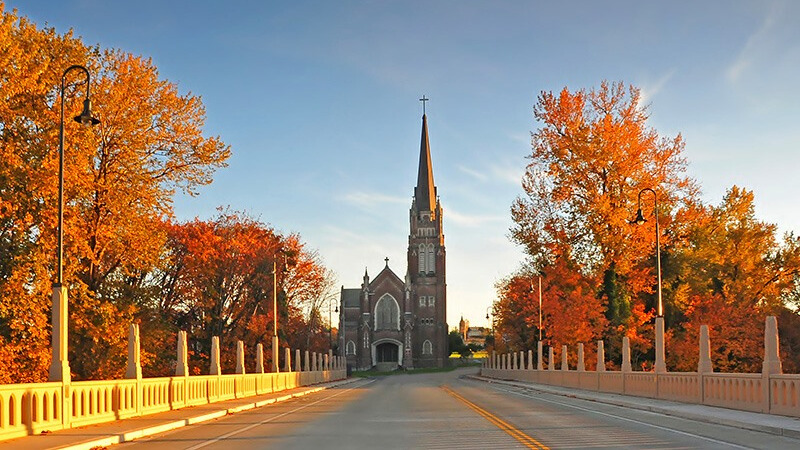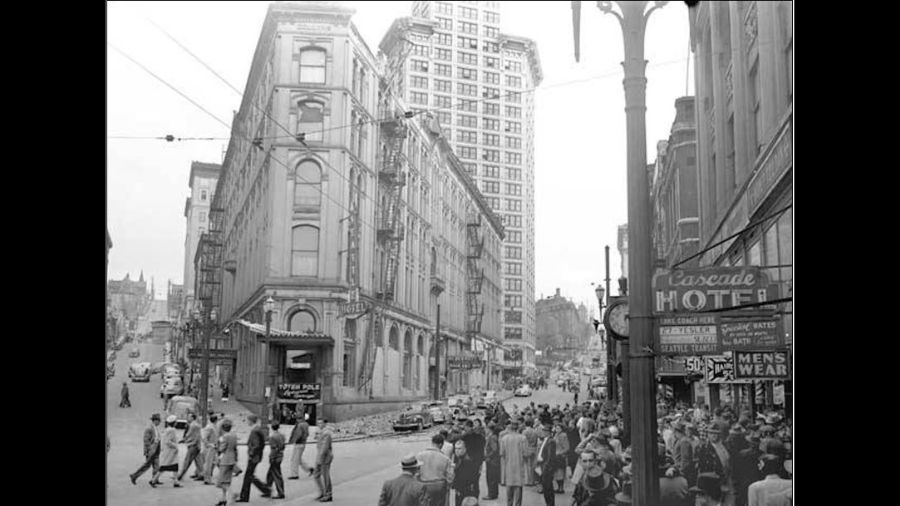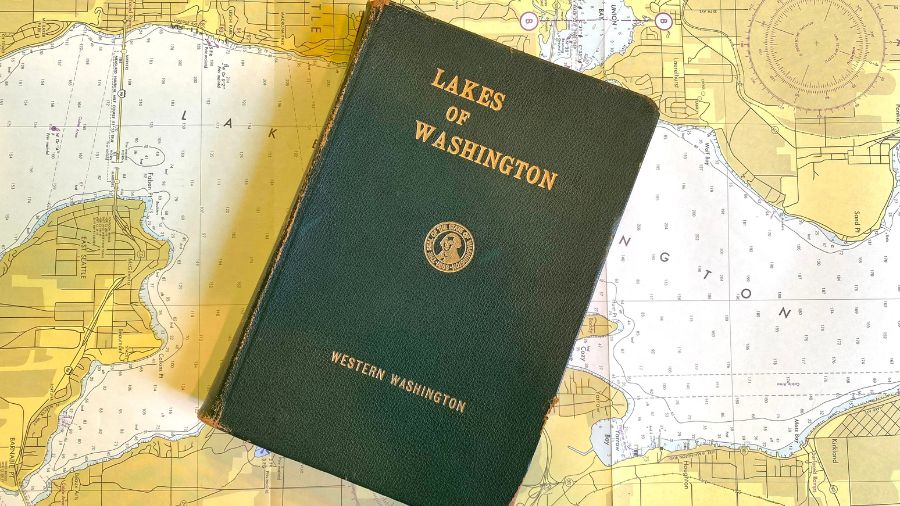Remembering the big Columbia River flood of 1948
May 3, 2023, 9:04 AM | Updated: 9:32 am

Aerial view of Vanport, Oregon during the big Columbia River flood of May 1948. (Courtesy Oregon Historical Society)
(Courtesy Oregon Historical Society)
It was 75 years ago this month when the Columbia River and its tributaries suffered one the biggest floods in the Northwest of the 20th Century. To mark the occasion, KIRO Newsradio spoke to an expert on weather history, and to some eastern Washington senior citizens who were first-hand witnesses to the big flood of 1948.
Not many people are around anymore who remember the deadly floods of May and June 1948, which devastated communities in the Columbia Basin in British Columbia, Washington, and Oregon – and wiped out the community of Vanport near Portland.
An old newsreel describes what happened there.
“The swollen Columbia River bursts through a railway embankment to sweep out of existence the whole town of Vanport, Oregon,” the British narrator says. “18,000 are rendered homeless within the hour. Scores perish in the flood waters despite the effort of quickly mobilized rescue workers. The railway embankment was considered a safe wall against the raging river, which now bears houses away like matchwood.”
News reports from the time say more than 50 people lost their lives, including 16 at Vanport. Damage in Washington and Oregon was estimated at $100 million, or about $1.2 billion in 2023 dollars.
Scientific reports from as early as 1949 point to a rare confluence of three major factors which contributed to the deadly and destructive circumstances of the 1948 flood.
There was a big snowpack that year throughout the Cascades, as high as 200% of normal in some areas. And the weather stayed cool throughout April and right into mid-May when temperatures suddenly spiked. Around the same time, a massive rainstorm brought even more moisture into just the wrong areas of the Columbia Basin.
Larry Schick is a former KING 5 TV weatherman and retired Army Corps of Engineers hydrologist who’s studied Northwest weather history for decades.
He says the 1948 flood wasn’t because of El Niño or La Niña or some other easily identifiable climatology trend.
“It was just a random event of everything coming together,” Schick told KIRO Newsradio. “This deep snowpack, this cold, then the switch to warm [temperatures,] and then rain on top of that.”
In the months before the flood came, scientists knew something was up as early as March 1948. On May 1 – just a few weeks before the flood – a U.S. Weather Bureau report warned that “April precipitation over the Columbia Basin was unusually large, and runoff forecasts have been modified upwards very considerably over most of the area.”
Schick says that in 1948, there were no weather satellites yet, computer modeling was in its infancy, and forecasting, in general, was not as sophisticated as it is today.
“Now, that said, it wasn’t like there was a surprise of rain,” Schick said. “They just wouldn’t have known two weeks ahead of time. They did know that it was above normal snowpack, so they did anticipate higher-than-normal runoff, but they had no way to anticipate how quickly [temperatures] would flip.”
While the flooding at Vanport was the deadliest and the most destructive, damage occurred throughout the Columbia Basin in Washington, Oregon, and British Columbia, as well as the Fraser Valley and Vancouver, BC.
One of the places hit hard in Washington was the community of Pateros, which is about 20 miles upriver from Chelan, where the Methow River enters the Columbia.
Phil and Joan Brownlee of Pateros are in their 80s. They’ve been married since 1955 and have known each other since first grade.
In May 1948, Joan Brownlee was in sixth grade. Her family had been in the area since 1910 and had 200 acres of apple and pear orchards in the hills above town along the Methow. In a matter of hours, all that extra water in what had been a meandering river washed away big swaths of land and the orchard’s cold storage building – along with 5,000 apples inside of it.
Joan Brownlee could see damage everywhere she looked.
“We lived up on a hill,” Brownlee told KIRO Newsradio. “My friends, my family, we could sit on the road down to the Methow Valley Road and watch our neighbor’s cabins. He had cabins for his harvest crew, and we could see those cabins falling into the river.
“For a 12-year-old, it was very scary,” Brownlee said.
The family’s easy access to town was cut off since most of the bridges across the Methow were undermined or had their approaches washed away. The only way to get anywhere was on a glorified dirt trail known as “the old wagon road.”
On top of that, they lost electric power for six weeks.
“My folks had had a wood stove in their kitchen for years,” Brownlee said. “And in January of that year, my dad got mom an electric stove – so, out with a wood stove and us girls having to fill the wood box. Well, the flood came, and no electricity. So, back in came the woodstove.”
Fortunately, while Joan Brownlee’s father had moved the woodstove out of the kitchen, it was still out in the barn and able to be brought back and reinstalled.
Around the region, the bigger impacts of the 1948 flood lasted longer than a six-week power failure, says Schick. And some good came of it on both sides of the border.
“I think what was critical about 1948, too, after the flood,” Schick said, was that “this really invigorated flood control and building of dams for irrigation, power, hydropower, that sort of thing, not only in Washington and Oregon but also up in British Columbia.”
One side note – the Columbia River Basin is jointly managed by the United States and Canada through a treaty that expires next year and is currently being renegotiated with the Canadian government by the U.S. State Department.
Meanwhile, back in Pateros – irrespective of the diplomatic talks between D.C. and Ottawa – folks like the Brownlees, with decades of apple and pear-growing in their blood, well, they just keep doing what they’ve been doing.
Joan and Phil Brownlee told KIRO Newsradio that, along with the 1948 flood, their community has been no stranger to major disasters. They described two more recent events – crippling low temperatures of a bitter cold snap in 1969 that broke branches on fruit trees and the Carlton Complex wildfire of 2014.
For all those disasters, the Brownlees and their neighbors have developed a little catchphrase.
“So we say it’s the flood, the freeze, and the fire that’s really impacting the economy of our area,” Joan Brownlee said.
So, why not leave before some other bad thing happens, like an earthquake or a plague of locusts?
“Oh no, I don’t think we will,” Joan Brownlee said.
“We’re on high ground,” Phil Brownlee added as the two both laughed heartily.
Pateros is their home, so the Brownlees are sitting tight. They don’t operate an orchard anymore, and they have great-grandkids in the area and lots of their sporting events to attend, as well as a weekly community coffee gathering they’ve grown fond of.
Plus, all those dams and levees and other flood control measures mean the region is unlikely to see anything like the 1948 flood ever again – not to mention anything like the big flood of 1894.
Phil Brownlee is too young to remember that, of course, but his family came to the area in 1901. He has childhood memories of old-timers talking about what had happened around Pateros in 1894, including entire “haystacks floating down the river with chickens on top.”
There was one last piece of business to ask about: what became of those 5,000 apples that washed away in the family’s cold storage building?
First, Joan Brownlee says, her father didn’t have flood insurance, but he sure learned his lesson about where to rebuild.
“The cold storage wasn’t rebuilt down by the river, it was built on upper ground,” Brownlee said.
And the apples?
“Somebody from Kennewick wrote to my folks and said they sure enjoyed the box of apples that they dug out of the Columbia River,” Joan Brownlee said, chuckling. “Our family wasn’t too happy about that.”
You can hear Feliks every Wednesday and Friday morning on Seattle’s Morning News with Dave Ross and Colleen O’Brien, read more from him here, and subscribe to The Resident Historian Podcast here. If you have a story idea, please email Feliks here.



